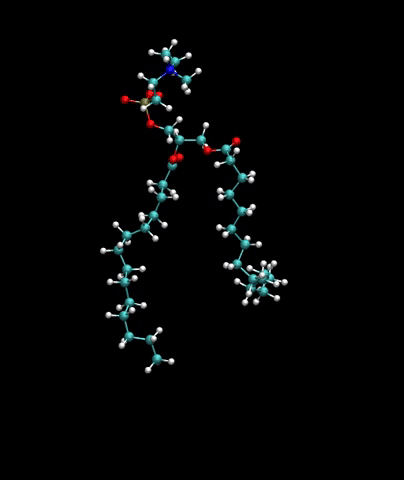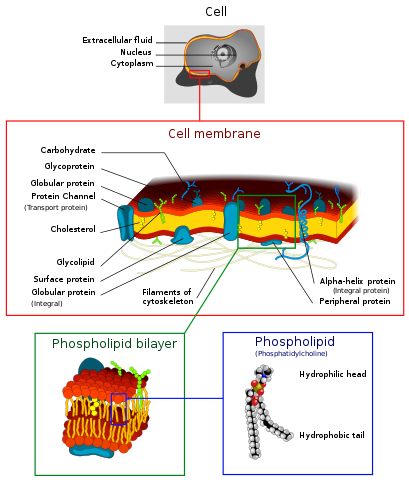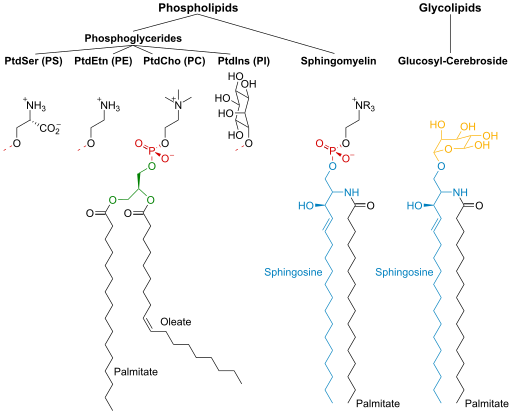Hi friends, I am back. This time I thought I will discuss phospholipids which are the main components of cellular membranes. And there are 2 reasons for that:
This will be a continuation article from the previous post where I emphasized on the significance of self-organization processes and molecules which take part in such processes. Previous post here: Information-driven processes versus Self-Organization processes in Biology
Secondly, I am going to give a talk on our work at my institute next Thursday. And it is related to the phase transition in lipids. ;)
So let us start with a small animation from Molecular Dynamics simulations highlighting a single DMPC lipid. I will explain what a DMPC molecule is in the coming section.

Cellular Membranes
Most of us naively classify lipids or fats as unhealthy in daily life. But let me tell you that these molecules are very vital for the existence of life on this earth. As I mentioned in the previous article here, although lipids not mentioned in the central dogma of biology it deserves the equal status of importance. Why? Simply because cells won't exist if there were no lipids! As simple as that. And cells are the building blocks of life. We classify living organisms based on cellular features. We have single cell organisms like bacteria, archaea, yeasts and multicellular organisms like fungi, humans, plants etc. We also know that the information content which gives us our identity is coded in our genome which is stored in sequence form of DNA molecule chains. And proteins are the workhorses which execute the instructions in this genetic codes. Yes, I have really oversimplified the exact biology. Still, this is a first-order approximation which will work well. Now think about a real cell. So, first of all, any cell requires a protection to cover itself from the external world. Otherwise, the cell constituents will flow outside and life will not be possible. Here comes the cellular membrane. Cellular membranes in living organisms are mostly made up of lipids(phospholipids and glycolipids), cholesterols, some protein molecules and few carbohydrates. But calling the membrane a protective cover is not proper in reality because there are a lot of transport and diffusion happening through the cell membranes. Like nutrients go into the cell and waste is expelled. Also, membranes with the aid of different proteins act like a sensor too. So the real picture is a bit more complicated. Please see the below figure:

From Wikimedia Commons, License: CC BY-SA 3.0
To further enhance your understanding, I invite you to watch this TED-ed youtube video. This will give you a kick starter to the amazing world of membranes.
And in today's article, I will talk about phospholipids which come in many varieties. Specifically, I will focus on DMPC molecules.
Phospholipids
First of all, let us start from the anatomy of a phospholipid. There are numerous kinds of phospholipids like shown below:

From Wikimedia Commons, License: CC0 1.0 Universal (CC0 1.0)
DMPC (1,2-Dimyristoyl-sn-glycero-3-phosphocholine) membrane
As you might have imagined phospholipids has phosphate group which is linked to other groups. If it is linked to choline group, as shown above, we classify the lipid as phosphocholine (PC for short). Glycerol group which is connected to phosphate part via the phosphorous then connects to the long fatty acid chains. The long fatty acid chains are abundant in carbon atoms which are non-polar and thus hydrophobic. (In some PC lipids unlike DMPC, carbon chains have double bonds in them we call it unsaturated fatty acids, which can contribute to kink angles in the lipid tails and fluidity of the membrane.) And the head group comprising of charged phosphate is hydrophilic. So these phospholipid molecules are amphiphilic in the sense that they have water-loving hydrophilic heads and water-hating hydrophobic long carbon tails.

These lipids can form different structures like micelles, vesicles(made up of bilayer lipids) etc based on the environmental factors like pH, temperature etc. There can also be phase transitions in lipids.

Phase transitions in DMPC bilayer lipids
The phases of DMPC lipids can be divided into four. They are:
- fluidy disordered state,
- crystalline ordered state,
- Ripple state and
- fluidy ordered state
See this figure from an open-access article From biological membranes to biomimetic model membranes:

If you simplify what happens is this: Firstly as the temperature is less the lipids are more ordered and in gel state (crystalline ordered state). As the temperature increases and reaches a pre-transition temperature there are 2 states co-existing in the lipid, one ordered state, and another disordered fluid state. This is an intermediate Ripple state. As you keep on increasing temperature, the lipid becomes more disordered and fluid in the state especially when it reaches main transition temperature. Now there is one more intermediate state called liquid-ordered state which is attained with the help of addition of cholesterol. In the real cell membranes, its fluidity is mainly regulated by cholesterol. These molecules have the capacity to keep the lipid in fluid mode but keeps an order too in the system. In my opinion, cholesterol adds a negative feedback mechanism to the lipid bilayer for maintaining stable, but fluid state.
A Simulation Video
So this is a classical molecular dynamics simulation which we did and it comprises of a protein segment called NOGO66 which interacts with a DMPC lipid bilayer. And the water molecules are not shown for clarity.
For further reading :
[1]: Physical Biology of Cell by Rob Philips et al.. [This is a great book.]
[2]: From biological membranes to biomimetic model membranes
If you like my content please upvote and resteem it. Below are few of my recent posts, you may find interesting:
- Information-driven processes versus Self-Organization processes in Biology
- Why is it wrong to equate Shannon Entropy to Disorder?: Visually Explained!
- Evil genius series!: Building a crude EMG circuit
- Gradient, Divergence, and Curl: Visually Explained!
- The history and mystery of Belousov–Zhabotinsky reaction: Did it violated 2nd law of Thermodynamics?
I am currently doing three article series:
- Evil genius!: My experiments with electronics and other DIY stuff!
- Classical Molecular dynamics: Focusing on teaching and setting up a molecular dynamics simulation of atomic systems. (Dormant mode)
- Visually Explained!: Explaining technical concepts visually.
Join #steemSTEM
Join the active science community #steemSTEM at discord: https://discord.gg/BZXkmWw

All images without image sources are my creations :)
Follow me @dexterdev
____ _______ ______ _________ ____ ______
/ _ / __\ \//__ __/ __/ __/ _ / __/ \ |\
| | \| \ \ / / \ | \ | \/| | \| \ | | //
| |_/| /_ / \ | | | /_| | |_/| /_| \//
\____\____/__/\\ \_/ \____\_/\_\____\____\__/
I would just like to add that there is also a movement of phospholipid molecules between the two layers of a cell's membrane - transverse diffusion, or "flip-flop" transition, catalyzed by enzymes flippases, floppases and scramblases.
Completely true. But I usually don't really give lot of details in a single article. Maybe I should write a 2nd article. Or what about a collaboration? :P But I am serious. Also I have observed lateral and rotational diffusion in my simulations too. But flip-flop transition is in a higher time scale I guess. But not sure. Thank you for commenting to my article. This is something constructive. Let our reorganization in steemstem initiate positive discussions too. <3
Never heard of these before to be honest. Really interested to see these proteins now. As a simulation guy, now I wanted to see if I can try these in MD simulations.
The intricasy a single nano Cell-Membrane has in it stupifies me.This article reminds me of my 'Plus Two' biology class!
I'm making this comment to tell you that I have read this article completely and understood the nuances of the subject you are trying to convey. Thank you for quenching the thirst of many avid eternal learners like me!
Being A SteemStem Member
Good information !
The simulation for Proteins@Home and FightAids@Home does a variation of this. I am a member of World Community Grid since it started and I contributed all these years to it. Basically they are folding proteins looking for some specific energy levels to bind onto the virus and keep it busy.
Very very interesting field. Do you have specific software for such simulations? Is it open source or how does it work?
We use software called NAMD for molecular Dynamics simulations and vmd for visualization. Yes it is open source. Actually regarding it's working it's a very detailed thing. I am writing a MD series articles. But now in dormant mode. In short we are solving Newton's equations of motions of these molecular systems. Let me know if you need more details. The computations are very heavy by the way depending on your system.
Content type: Long



Awarded 3 out of 6 owls:
Good job!
Explanation: The originality owl was not awarded since it is only given when the material is explained in a creative way. The sexy science owl was not awarded since the content concerns technical material. The spelling and grammar owl was not awarded since there are quite a few article mistakes. (Note that the in text citation condition for the citation and source owl was wavered since the facts in the post mainly concern standard facts in this field)
Thank you @mathowl first of all.
Do you have any suggestions more how to make this article sexy? I would like to hear from you. Other 2 points I completely agree. How can I make a technical content thing sexy? Do you mean using animations or better illustrations etc? By the way, this is not a complaint okay. I was expecting 2 owls. I am happy to get 3.
The sexy science owl is awarded if the text is interesting for readers which have absolutely no background in the topic of the post. In this post there are many technical terms and some technical pictures (the wiki figure,figure 4 etc). These technical parts only have meaning if you already have some background. I think you can reduce the information of these technical parts to a simple idea which is accessible for everybody. For example I think the only thing you need from the DMPC section is the introduction of hydrophobic and hydrophilic.
It should be noted that writing a popular scientific article is much harder if the content is very technical. So the difficulty of getting the sexy science owl is very much dependent on topic.
+1 owl as of update #4:
@mathowl
When you call for an owl you never know how many are listening.
LOL :D
True that! Forgot about my friend, @mathowl. Will have to check him up :D
He's late for this post. Must be hunting somewhere.
Another owl??
Congratulations @dexterdev! You have completed some achievement on Steemit and have been rewarded with new badge(s) :
Click on any badge to view your own Board of Honor on SteemitBoard.
For more information about SteemitBoard, click here
If you no longer want to receive notifications, reply to this comment with the word
STOP